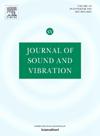Identification of bridge modal parameter based on tire pressure monitoring of two-axle vehicle
IF 4.3
2区 工程技术
Q1 ACOUSTICS
引用次数: 0
Abstract
In recent years, recognizing bridge modal parameter (MP) utilizing the vibration signals of passing vehicle has garnered significant research attention. To address the two major challenges in the practical engineering applications of this method, namely extracting vehicle-bridge contact point (CP) responses and eliminating the adverse effects of road roughness, this paper proposed a novel method for obtaining MP based on tire pressure variations of a two-axle test vehicle crossing the bridge. The process began by converting tire pressure variations into the relative displacement of the axle and contact point (RD of A-CP), which was then utilized in the vehicle vibration equations to solve for CP displacement. By subtracting CP displacements from two consecutive runs, the influence of road roughness can be eliminated. Subsequently, the residual response was subjected to variational mode decomposition (VMD) to obtain the modal components. The MP was identified by applying fast Fourier transform (FFT) and Hilbert transform (HT) to the decomposed components. Numerical simulations validated the adverse effects of roughness on MP extraction and demonstrated the effectiveness of the proposed elimination method. The responses from the two-axle vehicle's front and rear tires successfully identified the first three MPs, including frequencies and mode shapes. In field testing using an inspection vehicle, tire pressure variations effectively identified the first-order MP of the bridge.
求助全文
约1分钟内获得全文
求助全文
来源期刊

Journal of Sound and Vibration
工程技术-工程:机械
CiteScore
9.10
自引率
10.60%
发文量
551
审稿时长
69 days
期刊介绍:
The Journal of Sound and Vibration (JSV) is an independent journal devoted to the prompt publication of original papers, both theoretical and experimental, that provide new information on any aspect of sound or vibration. There is an emphasis on fundamental work that has potential for practical application.
JSV was founded and operates on the premise that the subject of sound and vibration requires a journal that publishes papers of a high technical standard across the various subdisciplines, thus facilitating awareness of techniques and discoveries in one area that may be applicable in others.
 求助内容:
求助内容: 应助结果提醒方式:
应助结果提醒方式:


